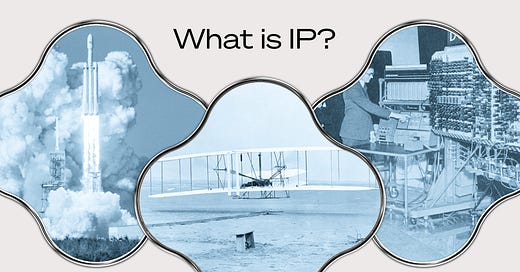What is IP?
IP is the world's most misunderstood asset class. When one hears the word IP for the first time, they typically think of Hollywood films or Billboard charts. That's confusing a single tree with the entire forest: IP is much more.
IP is the intersection where AI and blockchains will collide. And as AI grows more powerful, IP as we know it will die. But before diving into the future of IP, it's crucial to understand what it is.
My definition of IP: Intellectual Property is the atomic unit of ingenuity.
IP is scientific research (Merck, Pfizer, J&J), IP is the most iconic logos in the world (Nike, Louis Vuitton, Coca-Cola), IP is the best of creativity (Disney, BTS, Pokemon), and most personally, IP is your unique name, image, and likeness (Beyonce, Trump, Messi).
All of this constitutes a staggering 61 trillion USD asset class — comfortably one of the world's largest.
Beyond the commercial lens, IP is as fundamental to civilization as property itself: it is the collective vault of our ingenuity as a species.
Think of the Wright Brothers, the Mona Lisa, the discovery of penicillin, the first ever Nike shoe, the invention of the transistor, and the architecture behind DeepMind's AI models.
The most valuable IPs, if strung together chronologically, create a pretty comprehensive documentary of our rise as a species, and the entire world is racing to create the next IP that will usher in a new chapter of that ongoing human story.
IP is something that billion-dollar companies live and die by, that nations have gone to war over, and countless battles have been decided by the superiority of the victor's IP. IP is the gold, the oil, the silicon of the world of ideas.
Yet as AI grows more powerful, IP as we know it is dead.
Models are eating the grassy fields of internet data like an invasive species, and no one is incentivized to plant new seeds to keep the field alive. Without adequate compensation, no IP holder will ever grow ideas in this field again, knowing that it will simply get eaten away by the invasive species without consideration or reward.
This is tragic, because property rights are absolutely critical to flourishing societies. There are many accounts showing that nations that enforce and respect property vastly outperform their neighbors despite very similar starting points.
Yet AI as it currently stands, without blockchains, is creating a new Napster moment where our intellectual property is being disrespected without any compensation, incentives, or assent. This is not a future where ingenuity will flourish, but rather one where it will quickly die out.
It doesn't have to be this way. I am still a deep-rooted AI optimist. I truly believe that AI will usher in another Renaissance in civilizational progress. But as AI completely reshapes the value chain, we need to find a new, internet-native way of creating property rights around ideas. We need to reincarnate a new form of IP that can supercharge AI, one that does not succumb as its predecessor did.
There is a world where IP once again becomes the store of value for genius. In fact, this world is the most economically rational. The internet has brought the marginal cost of distribution to zero, and AI now brings the marginal cost of creation near zero as well. When all of these costs are brought to zero, what becomes the moat where value aggregates? Unique and original ideas — which, if tokenized and turned into property, is IP.
The question is not whether assetized ideas should be valuable, but rather, what technology is needed to reincarnate IP for an AI age.
This is the massive question that Story answers. We are creating a hyperstructure, a permanent and foundational cryptoeconomic network that brings IP onchain and makes it programmable.
If IP does not become software, it cannot survive. Blockchains provide the only way for someone to truly own software, and therefore, to truly own IP. Story is building what we hope will be the world's largest store of IP, a new, global, and permanent Library of Alexandria.
Story will be the rails upon which a market is created around IP. By connecting the world's largest AI companies with the world's largest IP holders, Story becomes the network by which a new digital market is created. Crypto needs to expand its horizons beyond creating endless forms of new currencies, and have something meaningful to spend all that currency on. IP is by far the most exciting exogenous asset to enter into crypto, one that transcends the recursive currency bubble that crypto is currently trapped in.
And perhaps most importantly, this new form of IP is the crossroads where AI and blockchains will intersect: truly autonomous AI agents need blockchains as a substrate for interacting with property, and on Story, AI agents will be able to learn by training on all of the IP on Story, while IP holders will be incentivized to store their IP on Story in order to earn from the massive gold rush surrounding the AI arms race.
The world's scientific ideas, creative works, and most alluring symbols will all be accessible and monetizable on Story. And these transactions are mediated not by people, not by paper, but by blockchains, which are the perfect intermediary, where code becomes law, and ideas become property for a software-native, AI driven future.











I'm pretty interested with the vision of story protocol
nice